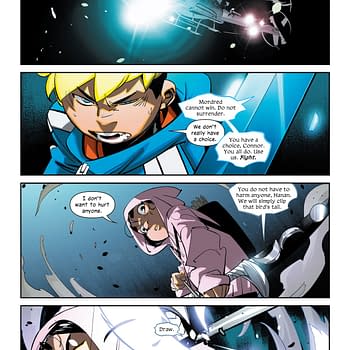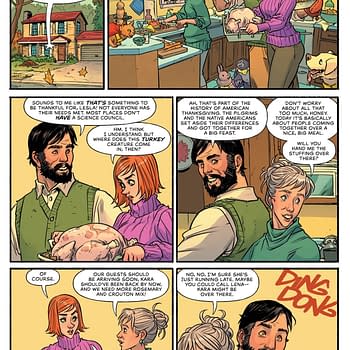Posted in: Comics | Tagged: avatar press, Comics, entertainment, kieron gillen, tony lee, uber
Writing Lesson – Kieron Gillen Addresses Number Of Panels Per Page
Kieron Gillen has a blog and on it he was asked about a comment he made in the afterward to Uber #17 having to do with panel structure. Gillen went on to create a great guide to addressing the number of panels on a page and how you work out how big to make a scene. Part of the response involved a conversation with writer Tony Lee. I've attached the beginning of the post here and link to the rest on his blog.
__________________________________________________________

Okay, this became a bit of an essay, so I'm going to put most of it beneath a cut. It's all really off the top of my head, so apologies for rambling, typos, etc.
Worth noting that before I write anything else here, there's a lot of implicit assumptions behind what sort of comic I'm describing, and the effect you're looking for.
The standard rule of deciding on panels is that there's one action per panel. Some people would add "per character" to that. Use those math to work out the panel count.
Also worth noting that not all writers call number of panels, but even if they don't tell the artist it, they're doing that sort of internal math to work out how much they can fit on a page.

SECRET AGENT walks along corridor, returning to his hotel room. He sees that his door has been disturbed. Getting out his gun, he bursts through the door to find the room empty… but there's water leaking in from the bathroom. He enters the bathroom with his gun drawn to find someone dead in the Bath.
The answers varied. When telling me it, Tony told me the artist he was chatting to did the maths and came out with 10-12 pages. Now, you can do it that way, and obviously get a lot of atmosphere from it… but that's over half a modern comic issue.
I think Tony's solution was a couple of pages – which I think would be a pretty conservative standard comic take. If Tony would excuse me, I think it'd be something like…
PAGE 1
1.1
Agent character walking down corridor. The door is open a little. Take this with the door in the foreground, looking down the corridor towards Agent character. We can see surprise.
1.2
Agent draws the pistol.
1,3
Agent opens the door, gun in hand. Nothing's there.
1.4
Agent notices water coming from bathroom…
1.5
Agent kicks open door to bathroom, with gun ready…
PAGE 2
2.1
Reveal on person in bath. Majority of page, probably. If it's an important character to the Agent, maybe a splash.
2.2
On Agent's response to the dead person.
There's different ways to move that around – maybe adding a sixth panel on the first page would be a fairly obviously useful call – my immediate urge was to add a response of the agent's face of what they see. Which would probably be horror – which would make 2.2 be a response of grief and/or sadness.
Al Ewing was in the room when I heard this anecdote, who did his own math, and said he'd do it in three or four panels. Al's a 2000AD writer, and can cut something right to the bone. Getting competitive, I think my own minimum reasonable take was 2. Which would have been…
For more of this writing lesson, follow this link back to Gillen's blog.














